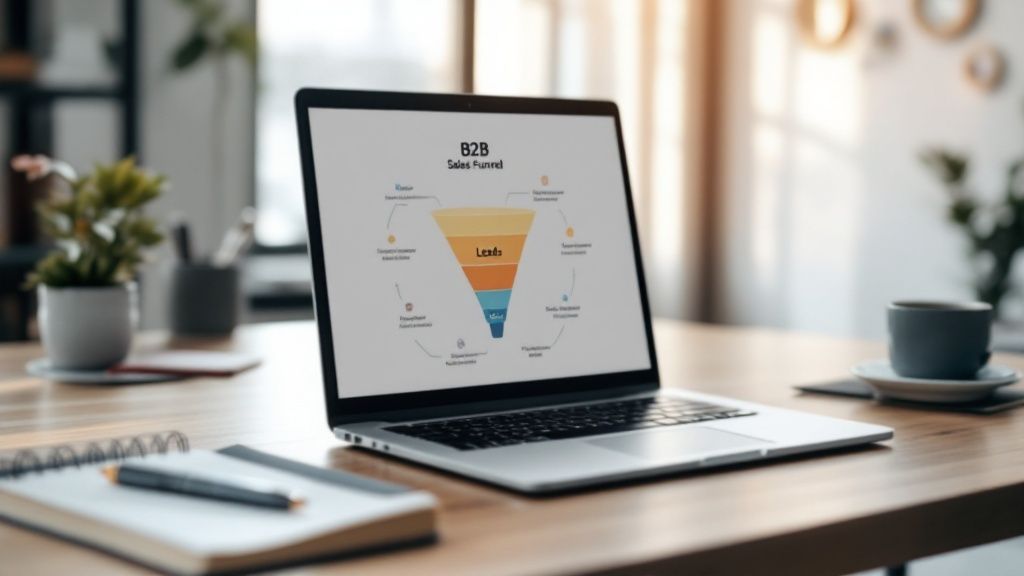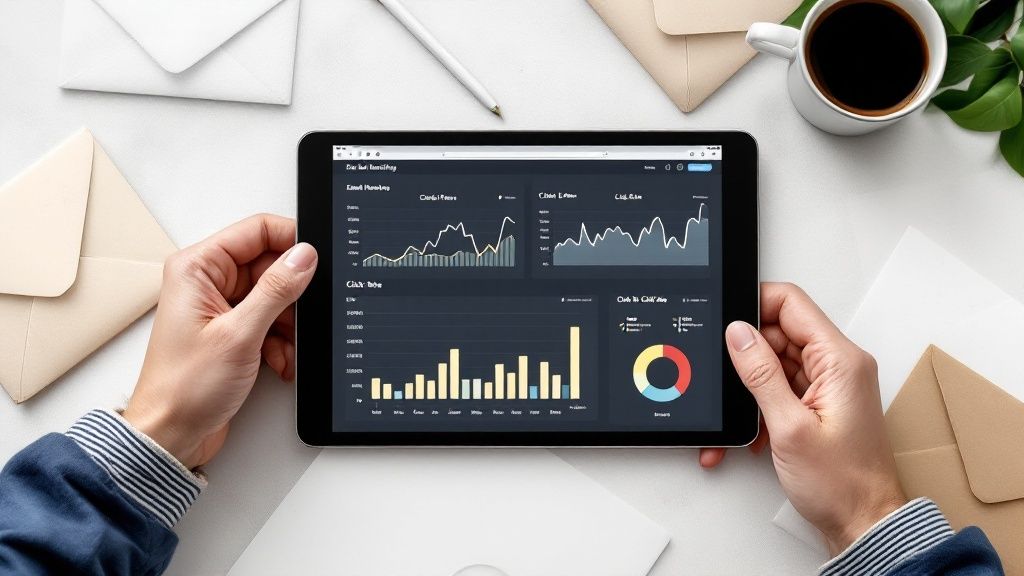Navigating Today's B2B Sales Lead Generation Landscape

Generating high-quality B2B leads has its own set of hurdles. The sales process isn't what it used to be. We've moved from straightforward outbound strategies to a more intricate, multi-channel world. This shift requires a new approach to B2B sales lead generation. It starts with recognizing the key distinctions between B2B and B2C strategies.
B2B sales often involve longer decision-making timelines and numerous stakeholders. This necessitates targeted strategies to effectively connect with potential clients. For a deeper dive into successful engagement strategies, check out our guide on How to Master Social Selling.
Understanding the B2B Buyer Journey
B2B purchases aren't impulsive decisions. They're the result of careful research, thorough evaluations, and consensus-building among multiple decision-makers within an organization. This makes understanding the buyer journey essential for effective lead generation.
Each stage – awareness, consideration, and decision – demands specific content and engagement tactics. Furthermore, the length of the sales cycle can fluctuate based on factors like deal size and industry. This calls for sustained effort and a strategic approach to nurturing leads.
Addressing Current Challenges in B2B Lead Generation
Sales teams are now battling intense competition for attention and rising acquisition costs. Cutting through the noise and showcasing value early on is crucial. A major trend in B2B sales lead generation is the growing reliance on digital platforms.
As of 2025, 89% of B2B marketers are projected to rely on LinkedIn for lead generation, making it an indispensable tool for connecting with potential clients. Additionally, 65% of B2B companies utilize paid social media for lead generation, underscoring the importance of these channels in expanding reach. This digital shift is fueled by the effectiveness of these channels in reaching broader audiences and fostering lasting relationships.
Interestingly, 56% of B2B companies rate their current lead generation strategies as effective or extremely effective. You can explore more detailed statistics here. While this suggests a generally positive experience with existing digital marketing approaches, there's always room for improvement.
Building a Sustainable Lead Generation Strategy
Despite the obstacles, sustainable growth is possible with the right approach. Successful B2B organizations emphasize targeted campaigns and personalized messaging. They prioritize building relationships and delivering value throughout the buyer journey. This fosters trust and establishes the company as a trusted advisor.
Furthermore, these organizations consistently analyze their performance and adapt their strategies based on data insights. You might find this resource helpful: How to Master LinkedIn Automation. This iterative process is essential for remaining competitive and maximizing returns on lead generation investments.
Building Your B2B Lead Generation Engine
Stop constantly chasing short-term tactics. Instead, focus on building a lead generation system that produces consistent, reliable results. By analyzing successful B2B organizations, we can identify the key components of a winning framework. This includes crafting detailed customer profiles that go beyond basic demographics, focusing on genuine buying signals. It also means defining Key Performance Indicators (KPIs) directly linked to revenue and developing lead scoring systems that prioritize quality over quantity.
Identifying Your Target Audience
The foundation of a strong B2B lead generation engine is a deep understanding of your target audience. This extends beyond simply knowing their industry and company size. You must understand their specific pain points, their decision-making processes, and the value they are actively seeking. This in-depth understanding empowers you to customize your messaging and tailor your offers to truly resonate with their needs.
The following infographic highlights key differences between small businesses and enterprises when it comes to deal size and decision-making timeframes:

As the infographic shows, targeting enterprises often means larger deal sizes, but also considerably longer decision cycles compared to small businesses. This underscores the need for separate strategies tailored to each segment, acknowledging the different timelines and resources involved. For a deeper dive into effective strategies, check out these B2B lead generation strategies.
Aligning Sales and Marketing
Effective lead management requires breaking down the barriers between sales and marketing teams. Successful companies create integrated processes, guaranteeing seamless handoffs and consistent communication throughout the entire buyer journey. This collaborative approach ensures that marketing activities generate qualified leads that the sales team can effectively convert. This translates to shared goals, regular communication, and a shared understanding of what defines a qualified lead.
Implementing Feedback Loops
Long-term success hinges on continuous improvement. Integrating feedback loops allows you to refine your lead generation activities using real-time data. This could involve examining campaign performance, collecting feedback from sales about lead quality, and making necessary adjustments to your strategies. This iterative process keeps your lead generation engine running smoothly and effectively.
Before we discuss automation, let's look at the crucial elements of a successful lead generation framework. The following table offers a comparison of these components, their impact on your business, and the complexity of implementing them:
Essential Elements of an Effective B2B Lead Generation Framework
| Framework Component | Business Impact | Implementation Complexity | Key Considerations |
|---|---|---|---|
| Customer Profiling | Increased conversion rates, improved targeting | Medium | Data quality, ongoing refinement |
| KPI Definition | Measurable results, data-driven decisions | Low | Alignment with business goals |
| Lead Scoring | Prioritized sales efforts, improved efficiency | High | Scoring model accuracy, data integration |
| Sales & Marketing Alignment | Improved lead nurturing, increased close rates | Medium | Communication protocols, shared goals |
| Feedback Loops | Continuous improvement, optimized campaigns | Low | Data analysis, feedback mechanisms |
This table highlights the interplay between business impact and implementation complexity. While defining KPIs is relatively straightforward and offers measurable benefits, implementing a lead scoring system requires more effort but can significantly improve sales efficiency. Finding the right balance across these components is key to building a robust lead generation framework.
Leveraging Automation for Efficiency
Automation plays a crucial role in scaling B2B lead generation. Tools like Salesloop.io can automate tasks such as email outreach, social media engagement, and lead nurturing. This frees up your team to concentrate on relationship building and closing deals. Learn more about effective LinkedIn automation in this article: How to Master LinkedIn Automation for Lead Generation.
By creating a well-structured lead generation engine, you can shift away from pursuing individual tactics and concentrate on establishing a system that consistently delivers high-quality leads. This proactive strategy promotes sustainable growth and sets your business up for long-term success.
Digital Platforms That Actually Generate B2B Leads

Building a successful B2B sales lead generation strategy requires a deep understanding of which platforms deliver qualified prospects. It's more than just having a website and social media presence; it's about finding the channels that truly resonate with your target audience. Discussions with top-performing sales leaders reveal the digital platforms that consistently make a difference.
LinkedIn: Beyond the Basic Profile
LinkedIn has evolved into a powerful engine for B2B lead generation. It’s no longer just a place for a digital resume. Effective strategies on LinkedIn go beyond simply posting generic content. They involve targeted engagement, well-crafted content, and building real relationships with decision-makers.
-
Thought Leadership Articles: Sharing insightful articles positions you as an industry expert and draws in high-value prospects.
-
Engaging with Industry Discussions: Participating in relevant conversations showcases your knowledge and helps you build connections.
-
Direct Messaging: Personalized outreach can be a highly effective way to connect with key decision-makers.
Consider how different industries consume information. Visually driven industries might prefer infographics and videos, while others gravitate toward in-depth articles and white papers. Tailor your content accordingly.
Building an Integrated Digital Ecosystem
Successful organizations understand that effective B2B sales lead generation relies on a multi-platform strategy. They build integrated digital ecosystems that nurture prospects across various touchpoints. This encompasses everything from initial contact through search engines to engagement on social media and targeted email campaigns.
Connect your digital channels strategically. For example, promote your latest blog post on LinkedIn, directing traffic to a specific landing page designed to capture leads through a compelling offer. This creates a smooth and engaging journey for potential customers.
Optimizing Landing Pages for Conversion
Driving website traffic is only the first step. Your landing pages must convert those visitors into qualified leads. This requires more than just an appealing design. It demands a clear value proposition, a compelling call-to-action, and a simple, user-friendly conversion process.
A high-traffic landing page with a poor conversion rate is like a fishing net with holes. You need to fix those holes by testing different elements. Experiment with headlines, calls to action, and form fields to discover what resonates best with your audience.
Retargeting: Recapturing Lost Opportunities
Not everyone converts on their first visit. Retargeting allows you to re-engage with prospects who initially showed interest but didn't take the desired action. This might involve targeted ads on social media or personalized follow-up emails.
Think of retargeting as a gentle nudge, offering additional value and addressing any remaining hesitations. Strategic retargeting campaigns can significantly boost conversion rates. Tools like Salesloop.io can streamline this process, automating follow-ups and personalized messages to improve your chances of re-engagement. This fosters lead nurturing and strengthens relationships over time.
Content That Converts: B2B Lead Generation Gold
Let's be honest: a lot of B2B content doesn't live up to its lead generation potential. Instead of attracting qualified leads, it sits unread. To fix this, we'll explore what actually drives successful content-driven B2B sales lead generation, based on what's worked in high-performing campaigns. This means knowing which content formats connect with your audience at each stage of their buying journey.
Matching Content to the Buyer's Journey
The buyer's journey isn't a single event; it's a process. Different content types work best at each stage. In the awareness stage, thought leadership pieces like blog posts and webinars can spark initial interest. As prospects move into consideration, more detailed content like white papers and ebooks offering deeper analysis becomes more valuable. Finally, in the decision stage, case studies, testimonials, and ROI calculators can influence purchasing decisions.
To help illustrate this further, let's take a look at the table below:
B2B Content Types by Funnel Stage
| Funnel Stage | Content Types | Primary Purpose | Lead Quality Impact | Conversion Rate |
|---|---|---|---|---|
| Awareness | Blog posts, webinars, infographics, social media updates | Generate interest, build brand awareness | Introduces potential leads | Low (1-3%) |
| Consideration | White papers, ebooks, guides, comparison reports | Educate prospects, position your solution | Qualifies leads based on interest | Medium (3-5%) |
| Decision | Case studies, testimonials, product demos, ROI calculators | Build trust, justify purchase | High – ready to convert | High (5-10%) |
This table highlights the relationship between content type and buyer stage. As you can see, matching the right content to the right stage can significantly impact lead quality and conversion rates.
Identifying Untapped Content Opportunities
Effective content marketing also means knowing what your competitors aren't doing. Find the content gaps in your industry. Are there specific pain points your ideal clients have that no one is addressing? Creating content that fills these gaps positions you as a go-to resource and attracts high-quality leads. A strong presence on LinkedIn is key, so consider a comprehensive LinkedIn content strategy to bolster business growth.
Strategic Content Distribution and Gating
Creating great content is only half the battle. You need a distribution plan, too. This involves promoting your content through various channels, including social media, email marketing, and paid advertising. Whether to gate your content (requiring contact information for access) is a strategic decision. Gating can generate leads, but it can also discourage potential prospects. Save gating for high-value content like exclusive research reports or in-depth guides. This ensures the perceived value justifies sharing their information.
Measuring Content Impact on Pipeline
Forget superficial metrics like page views and social media likes. Instead, focus on metrics that show real impact on your B2B sales lead generation efforts. Track conversion rates through the sales funnel, cost per qualified lead, and the revenue generated from your content marketing. This data-driven approach provides insights into which content pieces are performing best and informs your future content strategy. Regularly analyze performance and make adjustments based on the data to ensure your content delivers tangible business results.
Crafting B2B Lead Campaigns That Actually Deliver

Effective B2B sales lead generation requires more than just a strategy. It requires flawless execution. Many well-planned campaigns stumble due to poor implementation. By studying successful B2B campaigns, we can learn what separates high-performing lead generation from the rest.
This involves creating compelling value propositions, targeted messaging, and conversion paths built for complex B2B buying decisions. For more insights, check out this helpful resource: How to master effective lead generation.
Developing Compelling Value Propositions
Your value proposition is the core of your campaign. It's the promise you make to potential clients, explaining your advantage over competitors. This proposition must resonate with specific buyer personas.
It should address their pain points and showcase how your product or service offers a solution. Focus on tangible benefits like increased efficiency or cost savings, rather than general features. This targeted approach makes your message more impactful.
Crafting Targeted Messaging Hierarchies
B2B buying often involves multiple stakeholders with different priorities. Your messaging should address these varied perspectives. A messaging hierarchy structures your communication.
This ensures each stakeholder receives relevant information. This may involve creating separate messages for executives focused on ROI and department heads concerned with practical implementation.
Designing Optimized Conversion Paths
The B2B sales process is rarely a straight line. Prospects often engage through multiple channels before deciding. Your conversion paths must accommodate this, providing a seamless experience.
This involves strategically placing calls-to-action across platforms, guiding prospects to the next logical step. This ensures a smooth and personalized journey, regardless of their interaction path.
Optimizing Campaign Timing and Budget Allocation
Timing is crucial in B2B lead generation. A poorly timed campaign can significantly reduce its impact. Consider industry events, seasonal trends, and your audience's buying cycles.
Effective budget allocation maximizes ROI. Distribute resources strategically across channels, prioritizing those yielding the highest quality leads. This data-driven approach prevents wasted resources.
Creating Integrated Multi-Channel Experiences
Today's B2B buyers engage across numerous platforms. Your campaigns should deliver integrated experiences, connecting with them wherever they are, be it social media, email, or targeted ads.
This cohesive approach ensures a consistent brand message, reinforcing your value proposition at every touchpoint. This consistent presence strengthens brand recognition and trust.
Marketing Automation with Personalization
Marketing automation is essential for scaling B2B lead generation, but personalize it. Use automation to streamline repetitive tasks like email follow-ups. However, ensure your messaging remains tailored to individual prospects.
Balancing efficiency and personalization strengthens relationships and drives conversions. It shows you value their time and understand their specific needs.
Testing and Continuous Improvement
Even the best plans need ongoing optimization. Implement a testing methodology for continuous improvement. A/B test headlines, calls-to-action, and landing pages to see what resonates.
Analyze results and make data-driven adjustments. This iterative process maximizes your success chances. By constantly refining your approach, you’ll see better results over time.
Measuring What Matters in B2B Lead Generation
Are you tracking metrics that truly affect your bottom line? Or are you focusing on numbers that simply look impressive? Many businesses get caught up in vanity metrics—things like website visits, follower counts, and impressions. However, these often don't translate to actual sales. This section explores how data-driven sales leaders tie B2B sales lead generation to real revenue results.
Moving Beyond Vanity Metrics
High lead volume can be misleading. A large number of leads is meaningless if they don't convert into paying customers. Instead of volume, concentrate on quality indicators that predict sales success. Track conversion rates at each stage of your sales funnel. Calculate the cost per qualified lead. And, crucially, tie revenue back to specific lead generation activities.
This shift reveals what’s working and where potential customers are being lost. For example, a low conversion rate from marketing qualified leads (MQLs) to sales qualified leads (SQLs) might suggest a misalignment between sales and marketing.
Establishing KPIs That Drive Alignment
Key Performance Indicators (KPIs) should be more than just numbers on a report; they should reflect the shared goals of your sales and marketing teams. Choose KPIs valued by both departments. Some examples include sales-accepted leads, lead-to-customer conversion rate, and average deal size. This shared focus encourages teamwork and keeps everyone working toward the same objectives.
Also, set clear benchmarks for each KPI. This gives you a concrete target and helps you track progress. It lets you pinpoint areas for improvement and celebrate successes as a unified team.
Building a Data-Driven Culture
Tracking meaningful data shouldn't be a hassle. Use tracking systems that integrate smoothly with your current workflows. These systems should capture crucial information without adding extra administrative tasks. CRM software and marketing automation platforms can be helpful for tracking lead activity and campaign performance.
Create dashboards that clearly visualize the data. Focus on highlighting key trends and prompting action. User-friendly dashboards allow sales and marketing teams to quickly make data-driven decisions. This transparency fosters collaboration and enables informed strategy adjustments.
Optimizing for Continuous Improvement
B2B sales lead generation is an ongoing process of refinement, not a one-time project. Regularly analyze your data to find opportunities to optimize your targeting, messaging, and channel strategies. Use A/B testing to compare different approaches.
This data-driven strategy keeps your efforts effective and efficient. Testing different email subject lines, for instance, can show which ones result in the highest open and click-through rates.
By focusing on the right metrics, establishing aligned KPIs, and building a data-driven culture, you can turn your B2B sales lead generation into a predictable growth engine. This data-driven approach equips your team to make informed decisions, optimize campaigns for better results, and ultimately, increase revenue.
Ready to streamline your lead generation and automate your outreach? Salesloop.io is a powerful platform that helps you identify, target, and engage with high-quality B2B leads. From automated message sequences to personalized follow-ups, Salesloop.io helps you scale your outreach and boost pipeline growth. Learn more and sign up for a free trial at Salesloop.io.
Article created using Outrank





